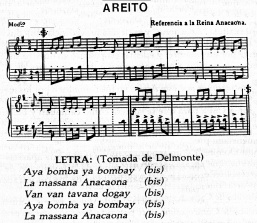
A Web Magazine Dedicated To Latin Music, Dance, and Culture Home, Music, Dance, Clubs, Events, Photos, New York, History, Culture, Poems, Contact Us |

A Web Magazine Dedicated To Latin Music, Dance, and Culture Home, Music, Dance, Clubs, Events, Photos, New York, History, Culture, Poems, Contact Us |
 When Christopher Columbus arrived in Cuba in 1492 one of the cultural expressions he
found was the "Areito"
a simple yet sweet music made by the native Taino people. The Tainos people lived in what
is today Cuba, Jamaica, Santo Domingo, Puerto Rico, and the Bahamas. They were a social
and industrious people that navigated the Caribbean to trade throughout the Antilles with
other Tainos, Siboneyes, and Caribe natives people.
When Christopher Columbus arrived in Cuba in 1492 one of the cultural expressions he
found was the "Areito"
a simple yet sweet music made by the native Taino people. The Tainos people lived in what
is today Cuba, Jamaica, Santo Domingo, Puerto Rico, and the Bahamas. They were a social
and industrious people that navigated the Caribbean to trade throughout the Antilles with
other Tainos, Siboneyes, and Caribe natives people.
The religious ceremonies that took place at gatherings and festivals were accompanied by music and dance. In the Areito the people would sing and dance, in a circle with their arms intertwined, to the sound of a drum. One member, either a man or a woman, guided the group. The dancers marked the rhythm of the music with their steps and sung in a choral fashion as they stepped forward and back while responding to the leaders phrases and repeating his dance steps. The topics of the songs lyrics were the stories of things past and were constantly being updated. The songs were both an oral history of the people as well as well as a news service.
The only existing Areito known today was found in the National Archives of Cuba. It is doubtful that it belongs to Cuban Tainos because it is titled and dedicated to Anacaona, the "cacique" princess of Santo Domingo. Strangely it is written in our musical system but it is without any harmonic combinations. Sources: La Historia de la Música Cubana, Elena Perez Sanjuro, 1986; The Journal of Christopher Columbus. |
|
Home,
Music,
Dance,
Clubs,
Events,
Photos,
New York,
History,
Culture,
Poems,
Contact Us
justsalsa.com Contact JustSalsa Terms of Use Copyright © justsalsa.com 1999 - 2013 NYC. All Rights Reserved. |